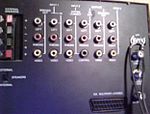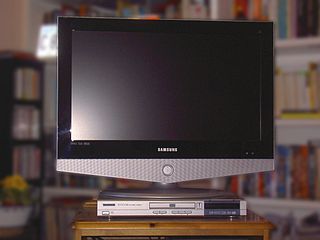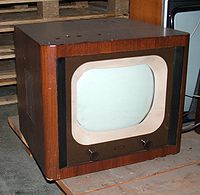- Television set
-
"TV set" redirects here. For other uses, see Television set (disambiguation).
A television set ( also called a television, TV set, Telly, or TV) is a device that combines a tuner, display, and speakers for the purpose of viewing television. Television sets became a popular consumer product after the Second World War, using vacuum tubes and cathode ray tube displays. The addition of color to broadcast television after 1953 further increased the popularity of television sets, and an outdoor antenna became a common feature of suburban homes. The ubiquitous television set became the display device for the first generation of home computers.
Modern television sets incorporate liquid-crystal flat-screen displays, solid-state circuits, microprocessor controls and can interface with a variety of video signal sources, allowing the user to view broadcast and subscription cable TV signals or Satellite television, recorded material on DVDdisks or VHS tape, or less common devices such as home security systems, and even over-the-air broadcasts received through an indoor or outdoor antenna.
Contents
History
Main article: History of television The RCA Dimensia and RCA Lyceum TV sets of the 1980s were early models to feature a wide variety of input/output terminals
The RCA Dimensia and RCA Lyceum TV sets of the 1980s were early models to feature a wide variety of input/output terminals
Mechanical televisions were commercially sold from 1928 to 1934 in the United Kingdom,[2] United States, and Russia.[3] The earliest commercially made televisions sold by Baird in the UK in 1928 were radios with the addition of a television device consisting of a neon tube behind a mechanically spinning disk (patented by German engineer Paul Nipkow in 1884, see Nipkow disk) with a spiral of apertures that produced a red postage-stamp size image, enlarged to twice that size by a magnifying glass. The Baird "Televisor" was also available without the radio. The Televisor sold in 1930–1933 is considered the first mass-produced television, selling about a thousand units.[4]
The first commercially made electronic televisions with cathode ray tubes were manufactured by Telefunken in Germany in 1934,[5][6] followed by other makers in France (1936),[7] Britain (1936),[8] and America (1938).[9][10] The cheapest of the pre–World War II factory-made American sets, a 1938 image-only model with a 3-inch (8 cm) screen, cost US$125, the equivalent of US$1,863 in 2007. The cheapest model with a 12-inch (30 cm) screen was $445 ($6,633).[11]
An estimated 19,000 electronic televisions were manufactured in Britain, and about 1,600 in Germany, before World War II. About 7,000–8,000 electronic sets were made in the U.S.[12] before the War Production Board halted manufacture in April 1942, production resuming in August 1945.
Television usage in the United States skyrocketed after World War II with the lifting of the manufacturing freeze, war-related technological advances, the gradual expansion of the television networks westward, the drop in television prices caused by mass production, increased leisure time, and additional disposable income. While only 0.5% of U.S. households had a television in 1946, 55.7% had one in 1954, and 90% by 1962.[13] In Britain, there were 15,000 television households in 1947, 1.4 million in 1952, and 15.1 million by 1968.[citation needed]
By the early 1970s, color television had come into wide use.[citation needed]
Components
Modern televisions consist of a display, antenna or radio frequency (RF) input (a TV aerial plug or an F connector), and a tuner. The existence of a television tuner (nowadays, a digital television tuner) in a display device distinguishes it from a video monitor — which receives signals that are already processed. Additionally TVs almost always include speakers and teletext. Most modern TVs also feature additional inputs for devices such as DVD players, video game consoles, and headphones; the most common types for analog audio and analog video are RCA (for composite video and component video), mini-DIN for S-Video, SCART and D-terminal can be found in Europe and Japan respectively, the newer HDMI (which can also connect to computers), USB and Bluetooth. Some high-end TVs have Ethernet ports to receive information from the Internet, like stocks, weather, or news. Most TVs made since the early 1980s also feature an infra-red sensor to detect the signals sent by remote controls.
Display technologies
Televisions today use various display technologies such as CRT, LCD, Plasma, Digital Light Processing (DLP), and more recently OLED. Some front projectors, which feature TV tuners, can also be considered televisions.[citation needed]
Outdoor television
An outdoor television set designed for outdoor use is usually found in the outdoor sections of bars, sports fields, or other community facilities. Most outdoor televisions use High-definition television technology. The screens are designed to remain clearly visible even in outdoor lighting. The screens also have anti-reflective coatings to prevent glare. They are weather-resistant and often also have anti-theft brackets. Outdoor TV models can also be connected with CD, DVD players and PVRs for greater functionality.[citation needed]
See also
- 3D television
- Active antenna
- Color killer
- Color television
- Digital video recorder
- Divx
- DTV transition in the United States
- HDTV
- Home theater
- Multiplier
- Personal video recorder
- TV aerial plug
- Viera Cast
References
- ^ Roberts, Donald. "Trends in Media Use". Journal: Children and Electronic Media. Princeton, Brookings. http://futureofchildren.org/publications/journals/article/index.xml?journalid=32&articleid=55§ionid=231&submit. Retrieved November 4, 2011.
- ^ Early British Television: Baird, Television History: The First 75 Years.
- ^ Pre-1935, Television History: The First 75 Years. The French model shown does not appear to have entered production.
- ^ Pre-1935 Baird Sets: UK, Television History: The First 75 Years.
- ^ Telefunken, Early Electronic TV Gallery, Early Television Foundation.
- ^ 1934–35 Telefunken, Television History: The First 75 Years.
- ^ 1936 French Television, Television History: The First 75 Years.
- ^ 1936 Baird T5, Television History: The First 75 Years.
- ^ Communicating Systems, Inc., Early Electronic TV Gallery, Early Television Foundation.
- ^ America's First Electronic Television Set, Television History: The First 75 Years.
- ^ American TV Prices, Television History: The First 75 Years.
- ^ Annual Television Sales in USA, Television History: The First 75 Years.
- ^ Number of TV Households in America, Television History: The First 75 Years.
External links
Categories:- Television technology
- Television terminology
Wikimedia Foundation. 2010.



